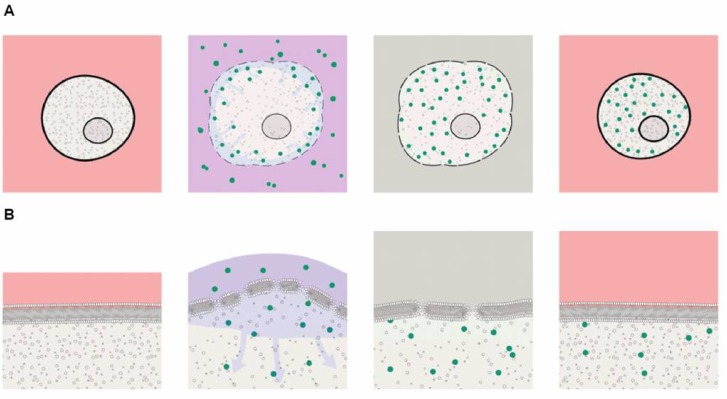Fig 8. Mechanism of action.
(A) Graphic representation of mechanism of action. Cells are initially in culture medium (pink). The cartoon illustrates a sequence lasting about 6 minutes. Ethanol the perturbs cell membrane and makes it susceptible to transient permeablization. Cell begins to swell as extracellular water moves into the cell due to the oncotic effects of the large molecules in the cytoplasm. Cargos now move across the membrane: For smaller molecules, the predominant mechanism would be diffusion. For larger molecules the osmotically-driven water influx (a process known as ‘solvent drag’) augments diffusion by carrying cargo into the cells and concentrating cargo at the cell membrane. Solvent drag may be particularly important for even larger molecules, where an additional tendency for molecules to be carried toward the membrane is a consequence of the spray mode of applying pressure-dependent mechanical force to the cells. We propose that the velocity of the spray droplets leads to a concentration of the larger molecules close to the cell membrane where they enter the cell by diffusion. The next critical step is resealing the membrane and restoration of cell viability. The standard histology fixation protocols use higher ethanol concentrations (>30%) and longer incubation times which result in loss of cell viability due to irreversible membrane permeabilization. Diluting the ethanol more than 50-fold with a PBS solution which is non-toxic to permeabilized cells enables the membrane to reseal (grey). After the cells are returned to culture medium water leaves the cell by the cell’s own regulatory processes as normal electrolyte osmotic gradients are restored. (B) A higher magnification view of the processes at the cell membrane. Exposure to ethanol (25%) thins the membrane so that the tension caused by cell swelling induces reversible permeabilization sufficient to allow entry of cargos as large as proteins and DNA plasmids. Subsequent washout of ethanol restores membrane thickness, reseals the cell membrane and enables recovery in culture medium.

